There have been quite a few posts lately regarding various rye breads, after finally getting my hands on a barley malt syrup, I decided I would try to bake one myself. I had borrowed Southern Ground by Jennifer Lapidus and decided to try baking her Danish Rye bread since I had almost all the ingredients. Being from the south of the US she includes sorghum syrup which I understand is common there, so I subbed the barley malt in for it.
Her recipe created a lot more levain than one needs, I didn’t check the calculations ahead of time and only realized that when the levain was being weighed, I’ve adjusted the recipe so there wouldn’t be any waste with future bakes. Her recipe was also for a 8x4” pan where I have a deep 9x4x4” Pullman so I think I would want to increase the final dough weight even more than I already have in the future to get a slightly taller loaf. That being said, it would be smart to actually taste this bread before baking it again in a larger size, I haven’t had a 100% rye bread in many many years so I don’t recall if I actually like them or not.
I wondered if I had underproofed the loaf given its short stature, but I think it would have torn as it baked if it was underproofed. The final proof went much faster than the recipe estimated taking only 2h45min instead of the 4-8 hours. When I saw a few holes appears on the top crust I started the oven and put the dough into the fridge to try to slow it down to avoid overproofing. As always the crumb will be most important and I won’t slice it open until tomorrow afternoon at the earliest.
Because I keep such a small amount of starter I added a first stage levain build in order to make enough levain. The ingredient weights for the 8x4” pan are from her book without adjustment other than adding the first stage. The weights for the 9x4” pan are my adjusted to fit a 9x4” pan but not yet increased to make a larger/taller loaf.
YIELD: 1 (8 X 4-INCH) PAN LOAF
First stage
10 g starter
40 g water
40 g whole rye flour
LEAVEN (8 TO 12 HOURS)
150g water
75g starter
100g whole-rye flour
SOAKER (8 TO 12 HOURS)
150g hulled pumpkin seeds
75g hulled sunflower seeds
100g cold water
DOUGH
100g warm water (about 85°F)
200g leaven
200g whole-rye flour
1½ teaspoons sorghum syrup or light molasses, I have barley malt
10g fine sea salt
soaker (above), drained
For 9x4x4” Pullman
First stage
6 g starter
24 g water
24 g whole rye flour
LEAVEN (8 TO 12 HOURS) I’ve recalculated the levain so there isn’t waste.
106g water
52g starter
71g whole-rye flour
SOAKER (8 TO 12 HOURS)
169g hulled pumpkin seeds
87g hulled sunflower seeds
113g cold water
DOUGH
113g warm water (about 85°F)
226g leaven
226g whole-rye flour
1½ teaspoons sorghum syrup or light molasses, I have barley malt
11.3g fine sea salt
soaker (above), drained
I would increase the ingredients by 50% if you wanted to fill the Pullman.
- Make the leaven: Measure the water into a small clear container with a lid, such as a widemouthed 1-quart mason jar, then add the starter. Using a spoon or your fingers, break apart the starter into the water. Add the flour and mix until fully incorporated. Cover and let stand at room temperature for at least 8 to 12 hours (it’s possible to let it go even longer, say, 14 hours), until fully developed (see image on this page).
- Make the soaker: In a container with a lid, stir together the sunflower seeds, pumpkin seeds, and cold water. Cover and let stand at room temperature for 8 to 12 hours, then drain and set aside.
- Make the dough: Once the leaven is fully developed, measure the water into a large bowl, then add the leaven and dissolve it in the water, breaking it apart with your fingers. Add the flour, sorghum syrup, salt, and drained soaker and mix until fully incorporated, squeezing and mixing all the ingredients together vigorously to make a smooth, claylike dough.
- Final rise: Grease an 8 x 4-inch standard loaf pan with olive oil or butter (if you’re not vegan, the butter is more commonly used in this Danish bread).
- Place the dough directly in the prepared pan, using wet hands to smooth the top of the loaf. Cover with a cotton or linen kitchen towel and proof at room temperature for 4 to 8 hours, until small holes appear in the top of the loaf. (The final proof time depends on how active your leaven is and the temperature of your kitchen.)
- Bake: Preheat the oven to 450°F. Bake for 10 minutes, then lower the oven temperature to 350°F and bake for another 45 minutes, or until the internal temperature reads 206°F.
- Remove from the oven and immediately transfer the bread from the pan to a cooling rack. Let cool completely, ideally for 24 hours, before slicing. If you would like a softer crust, remove the loaf from the pan and let cool for 10 minutes, then return it to the pan and let it cool completely.Image
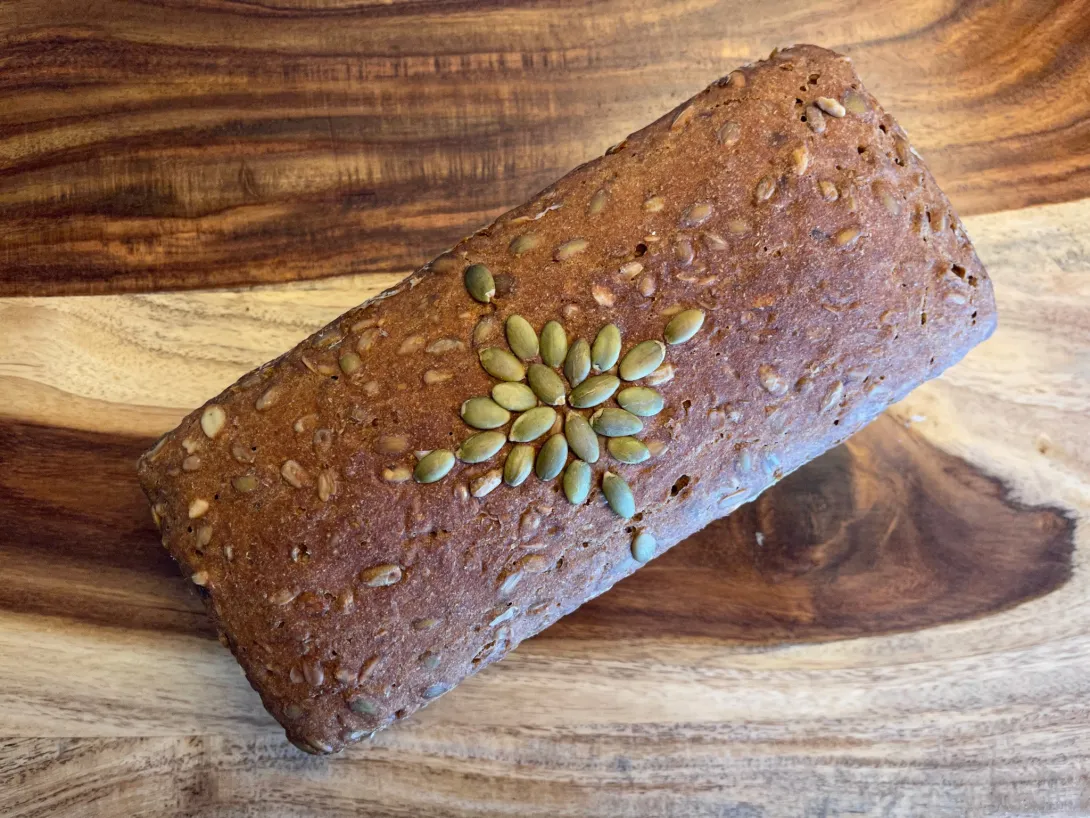 Image
Image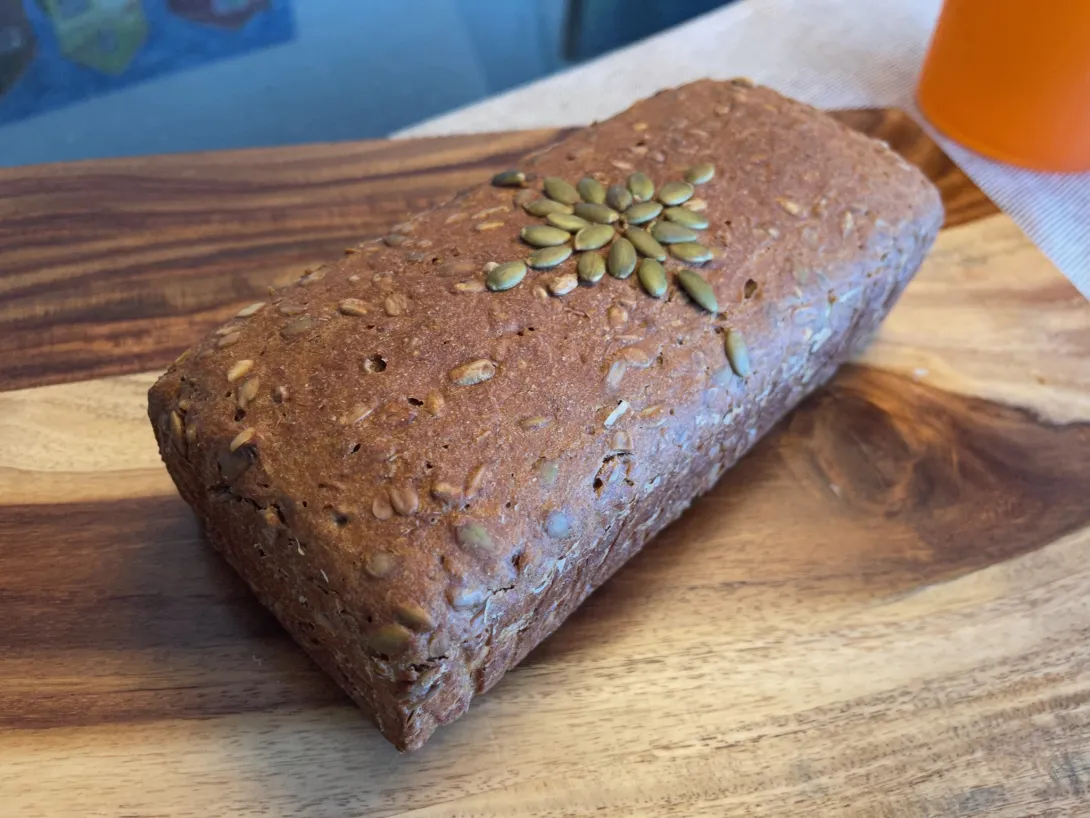 Image
Image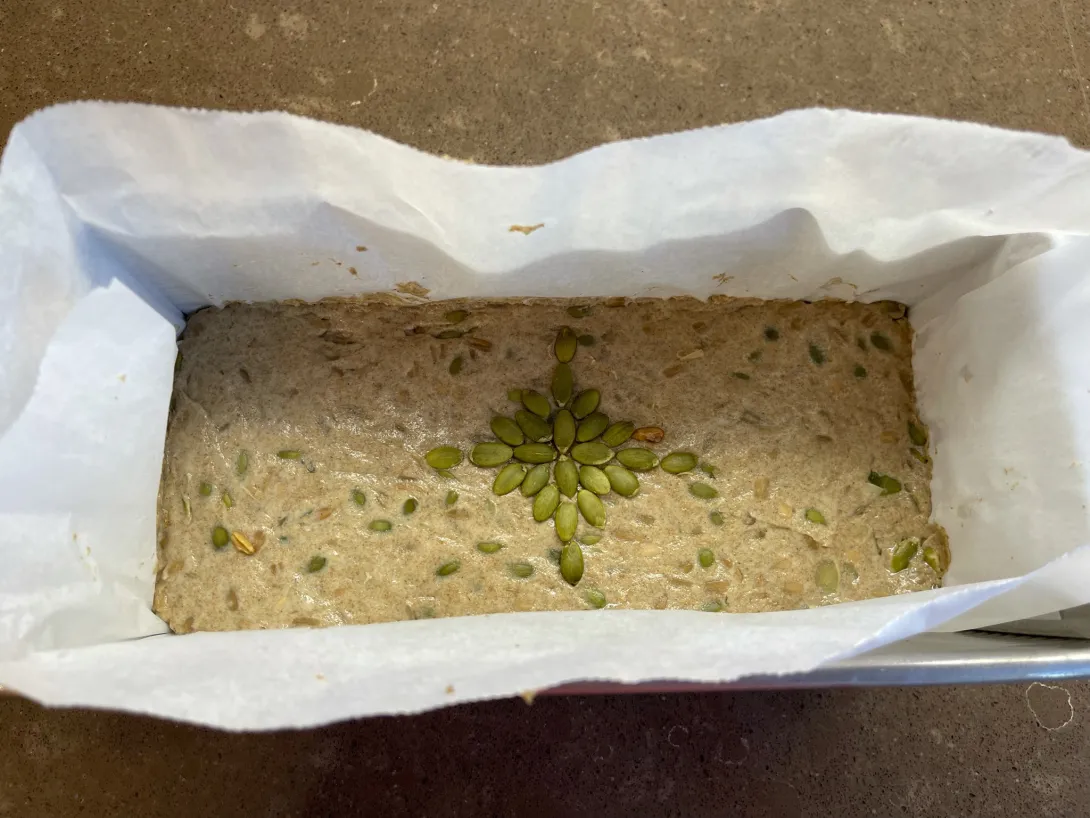 Image
Image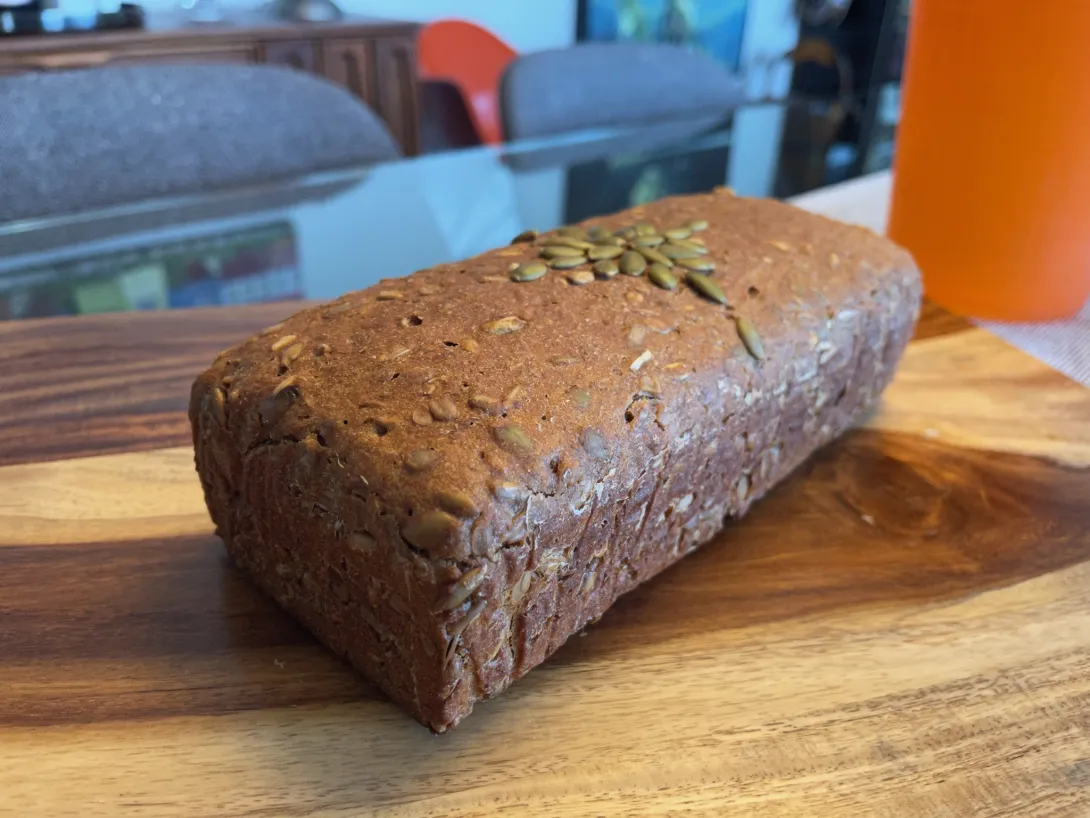
- Benito's Blog
- Log in or register to post comments
You seem to be scaling her recipe by 1.13 but a 9x4x4 pullman is about 2 times bigger than a 8x4x2.5 loaf pan. I think the volume of the pullman is about 2300ml and the loaf pan is about 950ml. Did I missing something?
Yes Gary I only adjusted for the change is the footprint of the pan and didn’t adjust for the change in height on purpose because I had no idea how much it would rise having had no experience with 100% rye breads before but I’d probably increase by another 50% to better fill the height of the pan. I also don’t know if I’ll like the taste of it so again I didn’t commit to baking it bigger. Oh also I didn’t have enough rye to bake it any bigger just enough left now to feed my starter a couple of times.
All good reasons. Thanks.
How much would you scale it up to fill the pan? Based on your current bake?
The baked height of this loaf was 2.75” so I’d increase it by another 45-50% to get it at or slightly above the 4” rim of the pan.
Thanks. 3" was my guess from the photo.
Is that correct? I guess all those seeds offset it.
The seeds are such a significant part of this bread when you include them the salt is 1.9% or so.
Thanks. I'm going to try a 4x4x4 version scaled to 216g of flour.
I should really buy a 4x4 pullman to testing new recipes, great idea Gary. Let me know how it turns out when you try it.
Nice looking loaf Benny, glad you stepped into the dark side with a 100% rye bread!
Please share what the crumb looks like, and how you like the taste. Lots of seeds surely will bring a lot of flavour. My only worry with the recipe is that the fermentation is done at room temperature, while rye really likes >28°C for good crumb texture and flavour, but hopefully this is not a problem with this recipe!
Ilya I would have stepped into the dark side of 100% rye baking sooner if I had been able to source the ingredients needed sooner. I may have tracked down a source of rye chops or cracked rye in the city in the suburbs as well. Unfortunately that is quite far away and doesn’t seem to open on the weekends so it may take a while before I can get there.
I actually did the final fermentation around 28ºC because its been very hot here lately without knowing that rye likes >28ºC so I’ll keep that in mind for the future. I hope I’ll like the flavour of 100% rye because it will give me a whole new world of baking to gradually explore. Am I correct to wait 24 hours to slice this bread to allow the crumb to cure or is longer better?
Benny
Apart from rye flour there aren't any really 100% needed ingredients, although there are a lot of recipes with other additives, like malt extract that you managed to find.
Well done! I'd say typically even the preferments are done at 28, and the final dough even warmer, but your process sounds reasonable 👍
24 hr should be enough to wait until cutting, but it'll continue to develop with time and will get better, usually around 48 hrs I find the flavour is best. It's interesting to see how it changes!
Ilya, I have come to understand this, with some time in rye land. I've never known why in Hamelman's Bread, all his starters are fermented 12-16 hours (I think most, if not all - not certain on this one) at room temp - which he specifies 70F. So, even the rye starters, cool temp. I used to think it's because he prescribes a longish starter development, but have since seen many others go as long and even longer, and at >27C. Exception being the Detmolder of course, where his temps follow the classic process.
I haven't seen if he seeds much higher than these other formulas. Any thoughts on this - what is it specifically about the higher temp that rye loves so much, comparatively speaking with respect to wheat? And what is going on at this optima that results in improved crumb and flavor?
Benny, I'd be redundant across your blog. I've really no comment as I can only learn. There's not a bread you do that doesn't flat out blow me away. Beautiful, creative, masterful, friend.
As I understand mostly from Rus Brot's explanations, LABs produce more lactic acid than acetic at higher temperatures. Lactic acid is stronger, hence it's much more efficient at neutralizing the enzymes (amylases, the same ones as we take advantage of in scalds) in the flour that would otherwise degrade the crumb when heated up during the baking. And to achieve this at lower temperatures you'd get a very sour bread, since you'd need a lot of acetic acid. I e. it's a pH vs TTA issue: low pH is important for baking and getting a good crumb, but TTA needs to be kept in check for the flavour, to avoid strong sourness.
I don't know why some authors recommend room temperature for starter maintenance. Perhaps their room temperature is room temperature in a bakery, where it's very warm anyway? Or such a long cold-ish preferment actually accumulates a lot of acetic acid, and you'd get a more sour bread, but maybe that's the goal for them, to get a clear tang? I'd guess that it's less important for the starter anyway, but more important for the dough...
Jennifer is from the south and most of her recipes are from other artisan bakers from the south or modifications of their recipes. I can only assume that their room temperatures are on the warmer side compared with someone like Hamelman. However, I doubt it is anywhere near 82ºF or warmer that I’ve read from your posts that would be more optimal for rye. Again I was surprised that my fermentation of the dough was completed so quickly compared to what she specified. It made me worry that I have underproofed it. But I went by the pin holes in the surface of the dough. Anyhow, it made me think that my final proof that I did warm around 82ºF was much warmer than hers.
Thanks for your comments Paul. You accumulating so much knowledge in bread baking and helping us all learn with your questions here. So thank you for your inquisitive mind.
Benny
Here are the photos of the crumb. We enjoyed two slices each with cream cheese, capers and smoked salmon. I like it but my partner isn’t sure. I find that the seeds really dominate the flavour. This being my first 100% rye sourdough I don’t really know what to expect of the crumb. If you bake 100% rye regularly can you comment about the crumb, is this what I should expect or does the crumb show anything that I should be doing differently next time, I’m all ears.
It looks excellent IMO! Well done!
Is there pronounced acidity? No stickiness, I assume?
Surprisingly I didn’t find it very tangy at all, in fact the over riding flavour is from the seeds. The crumb isn’t sticky at all, the knife is quite clean after cutting 5 slices. I am quite curious how it will taste tomorrow after another day of aging. Now I’m curious about trying a different recipe that doesn’t have inclusions to get a better idea of the rye flavour on its own. Stanley Ginsberg’s Tourte de Seigle might be my next rye bread but I’ll have to stock up on whole rye flour as this bake used almost all of my stash up. Thanks for your comments Ilya.
Benny
Sounds perfect. Unless you were looking for a sour flavour :) From my experience, tomorrow the flavour might get a little stronger, maybe you'll notice a bit more rye taste. But as you say, with so many seeds they will of course dominate.
I haven't baked recipe from Stanley Ginsberg, but he seems to know what he is talking about, and there have been positive mentions of his breads around here. Looking forward to reading about your experience with that recipe! It does look good, very simple and accessible.
Ilya, if you haven't found it, Stan's blog has free formulas at www.theryebaker.com
and his commercial website, www.nybakers.com
has formulas on the Resources page.
Thank you Dave, I know about it!
try the 100% rye Auvergne tourte de seigle. It's terrific.
Another recipe to try from the Stanley Ginsberg's site would be the Berlin Landbrot -- 90% rye, spiked with 4g yeast & 100% wonderful.
Oh, and btw, Benny, your bread, as always, looks fantastic.
Rob
Rob, Auvergne tourte de Seigle is on my list of ryes to try next. I haven’t seen the recipe for the Landbrot yet, I’ll have to look, thanks for the suggestions and comments, much appreciated.
Benny
I just mixed the first overnight stage for tourte de Seigle, we can compare notes when you are baking it too!
Oh excellent, I'm looking forward to see your bake Ilya!
your result & thoughts as well, Ilya. I've learned a ton from reading you & Benny, among others here on TFL.
Rob
Thanks Rob and Benny, the bread is baked, I'm waiting to cut it until morning at least.
It does suspiciously look very small... But I am not used to this style of rye bread. Will see tomorrow and will write a full report.
Yes ... I made 1.5 x the recipe & the loaves were flattish (see photo below....apologies for no crumb shot) They also took an hour and 15 minutes to fully bake. I look forward to your reactions.
Image
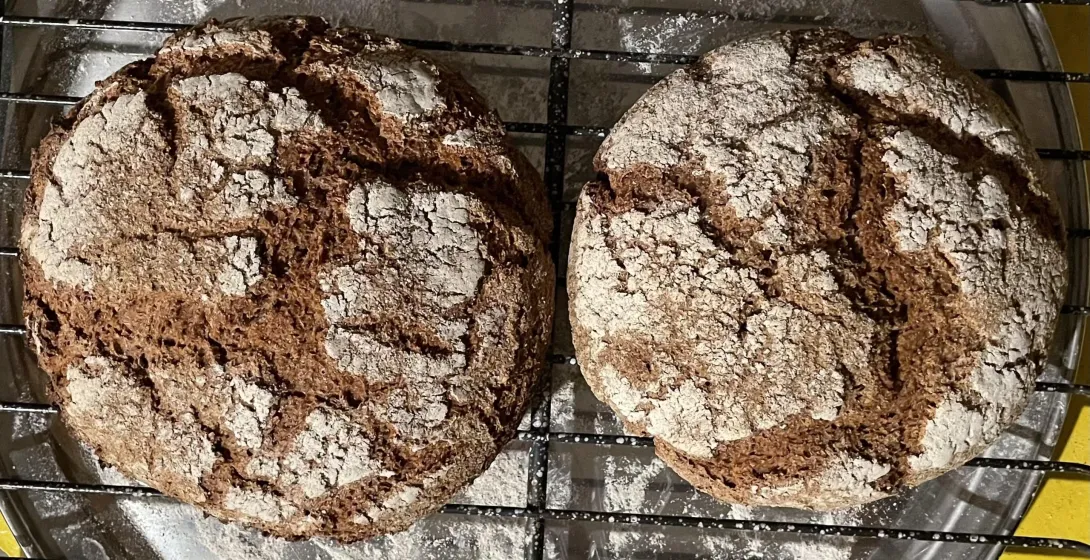
Rob, as you already know I have little experience with 100% rye other than this loaf. However, the loaves you just posted look good to me. I’ve always thought that 100% whole rye hearth loaves always look like giant christmas crinkle cookies and yours certainly have that look. I certainly wouldn’t expect them to be lofty loaves. I look forward to the crumb photos and tasting notes.
Benny.
tasting notes will have to come from Ilya. I baked these 9 months ago, when I was still trying to understand my starter (I think this may have been my first high %age rye bake) & I didn't have a scale so I converted everything to volume measures & blundered on. I had no idea what I was doing, but they came out great.
The flavour of this loaf is definitely improved after another ¾ day of aging. There is more tang and more rye flavour, I don’t think it will be a problem finishing this loaf. My partner independently commented that the bread is better today as well. I think my next loaf will be a different recipe without inclusions so I can really taste the rye and better familiarize myself with what it tastes like.
I wish rye meal and cracked rye were more readily available here in Toronto as there are some recipes that have those ingredients that I’m curious to try.
Glad to hear it aged well! I am still puzzled how and why this happens, but sourdough bread in general, and in particular wholegrain rye really does improve with time.
I have the same problem with rye meal / cracked / chopped rye - none to be found here. Still plenty of recipes to explore.
I have to thank you Ilya, your big interest in rye got me looking into it, so thank you.
Benny
Your crumb looks picture perfect. I’m not a fan of these types of bread but to each his /her own😎. If you enjoy hear types of breads there are so many variations you can experiment with.
Happy baking
Ian
Hey Ian, this is the first time I’ve made a 100% rye bread. I did like this one, but I wonder if that is because of all the seeds as that is the dominant flavour. I’ll have to make a different rye bread without so many seeds to see if I actually like the 100% rye flavour. The challenge without a mill is to get the ingredients, things like rye chops or course rye meal aren’t readily available anywhere near me. I have another recipe I’ll try to get a better idea of whether this is my thing or not. At least I know I can bake it.
Benny
And the crumb too. I have to agree with you that baking sooner was a good idea. It has a nice crust all around and is just beginning to open up in the center. The seeds look like they were helping to hold gas in the loaf and help maintain an even crumb. Very pretty to look at.
There may be a way to try to taste the rye. Mix up a small dish of seeds using the recipe seed ratio, mix well, then snack on a handfull to fill your mouth with seed flavour. Then when you're mouth is clear, bite into the bread to taste the difference. See if that works.
Play around with different seed mixtures to find something you like for future bakes. I would be soooo tempted to add in typical rye bread spices, just enough to elevate and complement the rye.
Mini
Thank you Mini for your kind words, I appreciate the comments. One thing I would say as I have eaten all but one slice of this fine bread, is that I do find the salt too high for my tastes. It wasn’t obvious at first but as I ate toasted slice after slice for lunches the high salt started to bother me. I would certainly take the salt down a notch but of course, keep an eye on fermentation because that will go even faster again with less salt.
I would try your idea for tasting the rye Mini, however, that last slice I will keep to use as Altus or crumbs for a future bake of a different rye bread that calls for it.
Benny